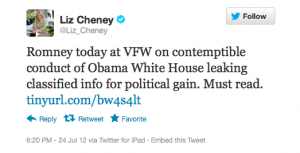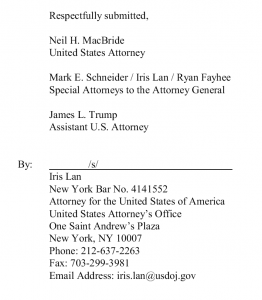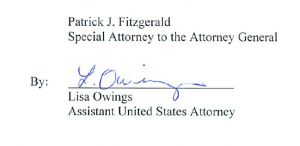Patrick Fitzgerald just finished his resignation press conference (the blockquotes are my notes).
In his own statements, he focused on comments to the people he works for, and those he works with. That was largely a tribute to the 300 people who work in the office, making it clear that the work he often gets thanked for publicly is done by those 300 people. He emphasized that those people would still be here working, doing good work.
I say that not just to make myself to feel less bad. Want citizens to appreciate what a treasure the people I work with are. The other part is that come June 30, that 300 plus team that is really hard working rolls on, and will keep rolling on. Fight against corruption, what we really need is public to keep coming forward.
Both in his opening statements and in later questions, Fitz seemed to want to encourage people to come forward to report corruption. He also talked about the problem of policing so aggressively that people being to fear the authorities.
We’d prefer to learn about corruption from people coming forward, not from a bug.
[snip]
When you start to see people being afraid of us, when citizens fear being shaken down, that’s a bad thing.
Jumping ahead, an emphasis on the continuity of the office is largely how he answered my question about MF Global. I asked whether DOJ had yet decided whether this office or SDNY would have the lead in that case. He refused to comment, but said anyone working in this office would continue to do good work. (Note, he said “this office,” not DOJ generally.) (I asked Randall Samborn later whether the decision on who had the lead in the MF Global case had been made and he would not say either.)
Fitz largely explained his departure in terms of a natural time to leave.
Not an easy decision. Am I rushing out in 11th year of my term. People have terms for a reason. Won’t be here until I’m 65. Comes a time when me and my family have to figure out what we do next. For the office it’s important that there be change.
I think it’s healthy after a certain point that there be change at the top. Always a matter of when, not if, I think you sort of know when it’s time.
As for what next, I don’t know, and that’s sincere. I’m going to run as fast as I can for 30 days that I have left.
When asked about whether he felt bad about the people he had jailed, he described the empty feeling he got after his first jury verdict on Valentines Day in 1989. As part of that, he emphasized that imprisonment is always a waste, not just in the case of white collar cases.
Feb 14 1989, first jury verdict day. Defendant convicted of drug offense. Taken into custody that day.
We think about prison in white collar cases, but we often don’t think about it on the violent side.
He also, in response to a question about being “overzealous” suggested it’s an injustice to bust the low guy on the totem pole without going after the top of the pyramid.
Someone asked whether there were any cases Fitz regretted not having charged. I called out, “Karl Rove.” He answered the question generally, without acknowledging my question. Harumph.
Fitz was asked whether he thought he could be a Defense Attorney.
I respect what defense attorneys do, but I don’t know what I’ll do next. There are some things I’m not comfortable with.
In response to a question whether he’d be interested in public service–possibly the FBI Director job–he said he had not been approached about the FBI job, but that if he was offered a public service job, he would certainly consider it, though he would balance the needs of his family.
Public service is in my blood. If a phone rings down the future and ID says public service, I answer the phone. I would consider if I can make an impact?
Finally, I asked if he had any reflection on our counterterrorism efforts so many years after he first indicted al Qaeda (note, I fucked up my question and said it had been 14 years; it has been 24 since the 1998 indictments). He said that they’ve made great progress against core al Qaeda. While affiliates remain a threat, core al Qaeda has largely been wrapped up.
We’ve made incredible progress. Core Al Qaeda has largely been rolled up. Remarkable progress in core al Qaeda.
He also emphasized the continuing, under-appreciated effort of FBI agents still chasing down leads.
Still dangerous threat out there we shouldn’t under-estimate. Remarkable job. People don’t appreciate people overseas,squads of FBI agents.
I did much better at this whole press scrum thing than I usually do, but as proof I’m not an expert yet, I failed to follow-up on what he thought about efforts to force terrorism trials into Military Commissions.
Finally, the funniest detail from the press conference. Apparently, when he called Dick Durbin to tell him he was resigning yesterday, the phone wasn’t working. He claims he may have missed most of the conversation.
When I spoke to Durbin yesterday phone was malfunctioning ,I missed a lot of call, may have had conversation in which I have no idea what he said.
There’s more in my Twitter stream. Plus, a plethora of questions about whether or not, as a Mets fan, he really could be baseball commissioner.
Glad I made it to the presser to at least ask a few serious questions. And make sure Karl Rove got mentioned as the single biggest person (Jon Corzine potentially aside) whom he didn’t prosecute.




